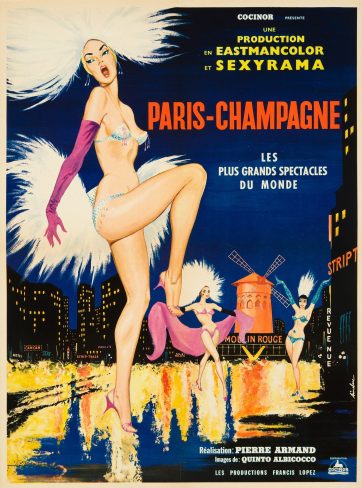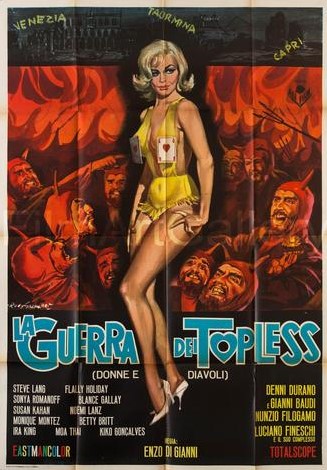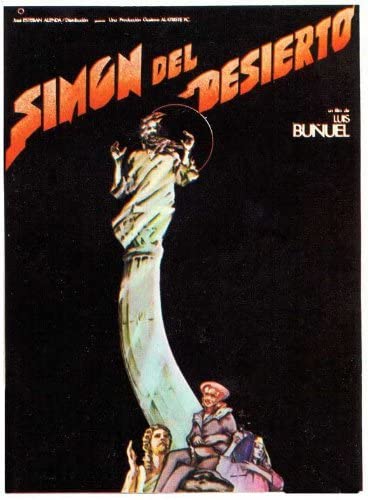Exotic dancers and the devil: a curiously appropriate pairing, especially in Europe. It was there that two exploitation films, the French PARIS-CHAMPAGNE and the Italian THE TOPLESS WAR/LA GUERRA DEI TOPLESS, were released in 1964. The films may differ in many particulars but contain a number of commonalities, most notably the devil-dancer combo.
Back in ‘64 the devil may not have been an especially popular element of European cinema, but strippers and exotic dancers definitely were. The first true “Mondo” films were, arguably, the Italian productions EUROPEAN NIGHTS/EUROPA DI NOTTE and WORLD BY NIGHT/MONDO DI NOTTE, which appeared in 1959. Both were done up in what would become the standard Mondo movie format, i.e. as freeform documentary travelogues, with the subject in both cases being European nightlife, in the form of cabarets, concert halls and strip clubs. The films were successful enough that they launched an entire mini-genre of Italian-made nightlife docos that included anti-classics like UNIVERSO PROIBITO (1963), SUPER SEXY 64 (1963), CANZONI NEL MONDO (1963) and SEXY HAUTE TENSION  (1964). There was also MONDO CANE (1962), co-directed by WORLD BY NIGHT’s screenwriter Gualtiero Jacopetti, which took a different approach (more on that in a bit).
(1964). There was also MONDO CANE (1962), co-directed by WORLD BY NIGHT’s screenwriter Gualtiero Jacopetti, which took a different approach (more on that in a bit).
Given the success Italy had with such fare, it makes sense that France would attempt its own Mondo-styled film. That film was PARIS-CHAMPAGNE (filmed in 1962 but not released until two years later), written and directed by Pierre Armand (of the 1961 sci fi comedy À REBROUSSE-POIL/AGAINST THE GRAIN). If PARIS-CHAMPAGNE is to be taken as a straight Mondo then it may be the most unique example ever made, falling as it does between a quasi-documentary exploration of nocturnal Paris and a surreal fantasy—think Russ Meyer meets Luis Bunuel.
It’s the “story” of a young woman florist stationed on the banks of the Seine who meets up with a tramp (played by the late French comedy superstar Jean Lefebvre), who somehow transforms himself into a handsome young man. As such he takes the gal on a tour of several burlesque clubs, resulting in a lot of highly suggestive dance numbers performed by gorgeous women in various stages of undress.
So far so Mondo, but around the twenty five minute mark the film takes a turn for the unexpected. Here the guy and gal take leave of the city in favor of a more rural environ, pursued all the while by the Big D (in the form of a frequently shirtless creep who rides a self-driving convertible). The proceedings grow increasingly dreamlike and disconnected, although the sleazy verve of the earlier scenes is maintained, with the erotic dances continuing as the cast is joined by rock bands, talking animals and (of course) sexy women.
Slick this film isn’t, with dialogue that occurs entirely in voice-over exchanges and dance routines that aren’t exactly prize-worthy. But the cinematic invention demonstrated by Armand is worthy of his nouvelle vague competitors, and the visuals are consistently gorgeous to  behold.
behold.
THE TOPLESS WAR, by contrast, is an exuberantly trashy camp-fest hailing from Mondo cinema’s birthplace: Italy. This film involves (once again) exotic dancers, the devil and some scenic locales—in this case the Island of Capri and the canals of Venice—visualized in colorful widescreen format. The Big D, who broadcasts his identity by wearing a red devil costume and wielding a pitchfork, presides over one of the silliest cinematic infernos on record. Therein he and his similarly outfitted fellows attempt to get attractive women to perform erotic (though nudity-free) dances, and then condemn them to Hell. To affect this the devil enlists a couple goofy guys to procure females from the aboveground world, and silliness ensues.
Those with a liking for Euro-slapstick will enjoy the film, whose true reasons for being are the erotic dance scenes. Thus it makes for an ideal pairing with the following year’s Ed Wood scripted “nudie-cutie” outrage ORGY OF THE DEAD (which should need no introduction).
Perhaps the most fitting comparison with THE TOPLESS WAR, and also PARIS-CHAMPAGNE, is a cinematic provocation that appeared in 1965 (but wasn’t unveiled in much of the world until several years later): Luis Bunuel’s Mexican made SIMON OF THE DESERT/SIMÓN DEL DESIERTO.  A black and white feature film that ended up a 43 minute short when funding dried up before filming was completed, it once again concerns the devil, here taking the form of a beautiful woman who mercilessly tempts the eponymous Simon (Claudio Brook), a religioso who’s decided to live atop a tall column to be closer to God. Eventually, though, he has a change of heart and heads back down, only to find himself stuck in a big city rock ‘n’ roll nightclub very much like those seen in the aforementioned Mondo movies.
A black and white feature film that ended up a 43 minute short when funding dried up before filming was completed, it once again concerns the devil, here taking the form of a beautiful woman who mercilessly tempts the eponymous Simon (Claudio Brook), a religioso who’s decided to live atop a tall column to be closer to God. Eventually, though, he has a change of heart and heads back down, only to find himself stuck in a big city rock ‘n’ roll nightclub very much like those seen in the aforementioned Mondo movies.
SIMON OF THE DESERT, for the record, was fairly successful despite its abbreviated runtime. The same cannot be said for PARIS-CHAMPAGNE and THE TOPLESS WAR, both of which had severely truncated releases. The primary reasons for this, I’d opine, were the changing times. Throughout the remainder of the 1960s (and into the following decade) devils and strippers were popular cinema components in and out of Europe, but the relative innocence in which they were presented in those earlier films had no place in the latter part of the decade, when filmmaking (reflecting the times) grew appreciatively darker.
One need only look at the Mondo tradition that birthed these films. The film that “started” the tradition is often identified, incorrectly, as MONDO CANE. That film was, however, the most influential Mondo of its time, with depictions of animal cruelty and general freakishness that became staples of the cycle. See AFRICA ADDIO/AFRICA: BLOOD AND GUTS (1966) by MONDO CANE’s makers Gualtiero Jacopetti and Franco Prosperi, which follows virtually the same format but ups the carnage factor considerably, with on-camera executions in addition to the expected animal cruelty. This of course led to future Mondos like THE KILLING OF AMERICA (1981), SHOCKING ASIA (1981) and, most notorious of all, FACES OF DEATH (1978) and its sequels.
As for the devil, his next major appearance was in ROSEMARY’S BABY (1968), in which he made a far darker impression than he did in PARIS-CHAMPAGNE, THE TOPLESS WAR or SIMON OF THE DESERT. In ROSEMARY’S BABY, based on the bestselling novel by Ira Levin, the Big D impregnates a sweet young woman (Mia Farrow) in order to unleash the antichrist on the world—and, in a far cry from his relatively benign antics in the earlier films, succeeds! ROSEMARY’S BABY is generally credited with birthing the horror boom of the 1970s and 80s, so its influence on the portrayal of the Big D in cinema is undeniable.
Perhaps we shouldn’t be surprised that PARIS-CHAMPAGNE and THE TOPLESS WAR have been completely forgotten in the ensuing years. The former film, at least, still compels attention, while the latter registers as a definite curiosity item. Neither are what I’d call great, but in the Mondo category they rank pretty high.
